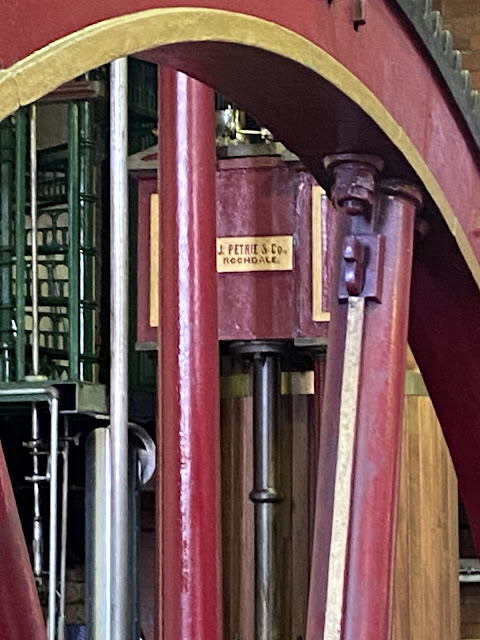Sunday 1st December 2024.
The world's largest "working" steam mill engine is 10 minutes in the car from my house and I cannot believe I've never been before.
I had friends coming to visit today and as Peter was also a tractor engineer I decided it would be a fitting trip. The engines, of which there are 3 working engines are only run on the 1st weekend of the month due to the high running costs and also everyone is a volunteer.
So where is this museum. It is found at Elizabethan Way, Milnrow, Newhey, Rochdale, OL16 4 LG.
Click on the link highlighted above for directions.
Ellenroad Mill was built by Stott and Sons as a spinning mill in 1890 and extended in 1899. Unfortunately it burnt down in 1916.
When it was rebuilt in the guise of the image below it was a ring spinning mill.
Ellenroad 2nd mill.
The mill was eventually made redundant as many mills were in the area and eventually knocked down in 1982. The building below the chimney and part of the building to the left of the chimney, and including the chimney is what remains today and where the engines are housed.
Ownership is now with the Ellenroad Trust.
As you enter the site the first door is the "Flock Ole". This is now a blacksmith's workshop and numerous machines are still working and run on the shaft and pulley system. Flock 'Ole was not a term I had come across before. It goes back to the days when the spinning took place.
The room originally had 4 large air fans which sucked air and cotton fibres out of the spinning rooms.
The "Flock" was flammable. The accumulated flock was used to stuff pillows and mattresses. Nothing was wasted. The fans are long gone.
The machines now are powered by a single cylinder Diesel engine.
I loved this workshop and as a time served turner, I was particularly interested in the old lathe.
Photos in the Flock 'Ole.
Left, Bench Fly Press, Centre the Blacksmith's Hearth, Right, Drop Hammer.
Don't be late! A clocking in station. It brings back memories of starting work in 1969.
Shaping Machine.
Another shot of the Drop Hammer.
The Lathe, I couldn't see a manufacturers mark and the Blacksmith wasn't sure.
My opinion is that it is a THUM Lathe. I could be wrong so I will take any suggestions.
From here we went to the next building which housed two engines and the boiler house. Also, a small cafe and numerous craft stalls. All very pleasant.
The Whitelees Mill Beam Engine.
The engine which catches your eye is the large beam engine on the left. It's the Whitelees Mill Beam engine.
The engine top beam with connecting rod and clevis.
This engine, came from Whitelees Mill in Littleborough which was a Raising and Finishing Mill. It was built and delivered to the mill in 1841 by Petrie of Rochdale. The engine finished working around 1946. But it is working today at the museum, restored to run on steam as originally built.
In 1957, CWS who had taken over the mothballed factory decided to get rid of the engine.
Alexander Petrie came from Cumberland, now Cumbria and opened a premises in Bury where his son John learned the trade. John went out on his own in Rochdale and took business away from his dad.
They eventually joined forces in Rochdale.
IRENE.
The next engine is called "Irene". It was bought by the society in 2016 from the R and GE Mill co. of Nottingham. Built about 1860. The engine is horizontal and weighs 7 Tonnes. Volunteers took 4000 man hours in it's restoration.
You can tell it was railway design.
From Irene we left the small hall and entered the grand hall which houses the Big Engine. The original Ellenroad engine. The largest working steam mill engine in the world.
The Big Engine.
This engine is now known as Victoria and Alexandria. It is now a twin tandem compound engine after being originally built as a triple expansion engine. Built by James McNaught of St. Georges foundry in Rochdale around 1892.
It was converted in 1920 to give more power. I think I heard right that it was 3000hp.
The steam for this engine was raised by 5 Lancashire boilers and needed a 200ft chimney to create enough draft.
The foundry which was on Crawford Street, Rochdale is no more. Replaced by a housing estate. But I managed to find a photo taken in 1992, Thanks to Geograph.
1992 image of St Georges foundry on the left, the redundant Rochdale canal and Moss Mill on the right.
Two of the Lancashire Boilers.
Cooling down the coal. Which is imported from South America.
More "Green Stupidity", it's ok to ship coal thousands of miles to UK at a hell of an expense but we cannot dig our own out of the ground. Bonkers planet huggers and politicians.
Diagram on the wall showing how the big wheel used to power crankshafts on the floors above.
The photo's don't do justice to the size of this wheel and the speed of rotation.
A scaled down model of the big engine layout.
Short video of the engine working.
Click on the lower far right button to enlarge the video and again to reduce the size on screen. (Button not on iPhones).




























Fascinating.
ReplyDeleteCheers Conrad.
Delete